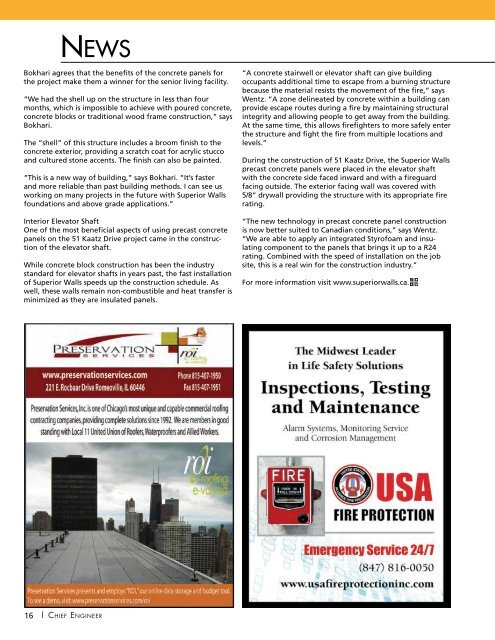Create successful ePaper yourself
Turn your PDF publications into a flip-book with our unique Google optimized e-Paper software.
NEWS<br />
Bokhari agrees that the benefits of the concrete panels for<br />
the project make them a winner for the senior living facility.<br />
“We had the shell up on the structure in less than four<br />
months, which is impossible to achieve with poured concrete,<br />
concrete blocks or traditional wood frame construction,” says<br />
Bokhari.<br />
The “shell” of this structure includes a broom finish to the<br />
concrete exterior, providing a scratch coat for acrylic stucco<br />
and cultured stone accents. The finish can also be painted.<br />
“This is a new way of building,” says Bokhari. “It’s faster<br />
and more reliable than past building methods. I can see us<br />
working on many projects in the future with Superior Walls<br />
foundations and above grade applications.”<br />
Interior Elevator Shaft<br />
One of the most beneficial aspects of using precast concrete<br />
panels on the 51 Kaatz Drive project came in the construction<br />
of the elevator shaft.<br />
While concrete block construction has been the industry<br />
standard for elevator shafts in years past, the fast installation<br />
of Superior Walls speeds up the construction schedule. As<br />
well, these walls remain non-combustible and heat transfer is<br />
minimized as they are insulated panels.<br />
“A concrete stairwell or elevator shaft can give building<br />
occupants additional time to escape from a burning structure<br />
because the material resists the movement of the fire,” says<br />
Wentz. “A zone delineated by concrete within a building can<br />
provide escape routes during a fire by maintaining structural<br />
integrity and allowing people to get away from the building.<br />
At the same time, this allows firefighters to more safely enter<br />
the structure and fight the fire from multiple locations and<br />
levels.”<br />
During the construction of 51 Kaatz Drive, the Superior Walls<br />
precast concrete panels were placed in the elevator shaft<br />
with the concrete side faced inward and with a fireguard<br />
facing outside. The exterior facing wall was covered with<br />
5/8” drywall providing the structure with its appropriate fire<br />
rating.<br />
“The new technology in precast concrete panel construction<br />
is now better suited to Canadian conditions,” says Wentz.<br />
“We are able to apply an integrated Styrofoam and insulating<br />
component to the panels that brings it up to a R24<br />
rating. Combined with the speed of installation on the job<br />
site, this is a real win for the construction industry.”<br />
For more information visit www.superiorwalls.ca.<br />
Chris Beebe, longtime owner and founder of the now-closed Foreign Car Specialists on Regent Street, shows off the inside of a 1958 Noble 200 microcar<br />
he’s restoring after the Midwest Microcar Museum in Mazomanie was flooded following August’s torrential rains in Springfield, Wis., Monday, Oct. 15,<br />
<strong>2018</strong>. (Amber Arnold/Wisconsin State Journal via AP)<br />
Wisconsin Man Repairs Museum’s<br />
Flood-Damaged Vehicles<br />
By Barry Adams | Wisconsin State Journal<br />
SPRINGFIELD, Wis. (AP) — Chris Beebe’s automotive resume is<br />
storied.<br />
For more than 45 years he founded, owned and operated<br />
Foreign Car Specialists in Madison, has raced a wide range<br />
of vehicles, worked as a racing instructor, written for automotive<br />
publications and developed hybrid vehicles, including<br />
the prototype for the Chevy Volt. From 2008 to 2011, he and<br />
a team even competed for the Automotive X-Prize.<br />
Water reached the bottom of the windows of the museum’s<br />
historic buildings and filled not only the passenger compartments<br />
of the cars but also the engines, lights and any other<br />
cavity below the waterline. And the water was far from<br />
clean. It contained not only mud, debris and likely sewage,<br />
but also oil from the vehicles. So when the water receded,<br />
every German Messerschmitt and Heinkel Bubblecar, East<br />
German Trabant and English Bond were not only soaked but<br />
left covered in a film of oil.<br />
Beebe’s latest effort is testing all of his skills, patience and his<br />
73-year-old knees and back.<br />
Since late August, Beebe has been self-sequestered in a<br />
storage shed on a farm north of Middleton and just west of<br />
Ashton where he is working to dry out, repair and restart 15<br />
cars and 13 motorcycles from the Midwest Microcar Museum<br />
in Mazomanie that were damaged in late August when<br />
torrential rains flooded the village.<br />
Even the Amphicar, a car that doubles as a boat, was damaged.<br />
It failed to float and the seals on its doors were compromised,<br />
which flooded the interior.<br />
“I’ve seen everything here but I haven’t seen the internals of<br />
many of these so it’s been a real eye-opening experience,”<br />
Beebe told the Wisconsin State Journal as he took a break<br />
(Continued on page 18)<br />
16 | Chief Engineer<br />
Volume 83 · Number <strong>12</strong> | 17


















